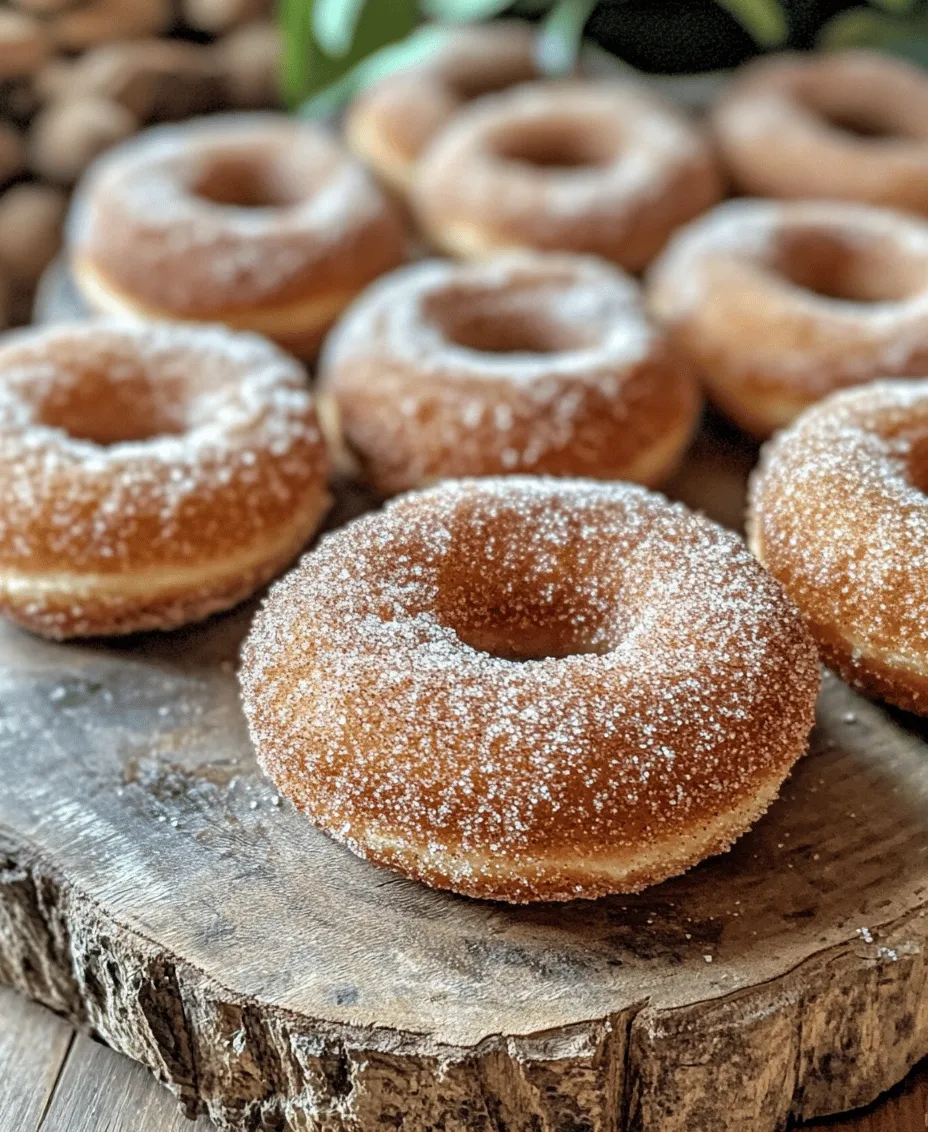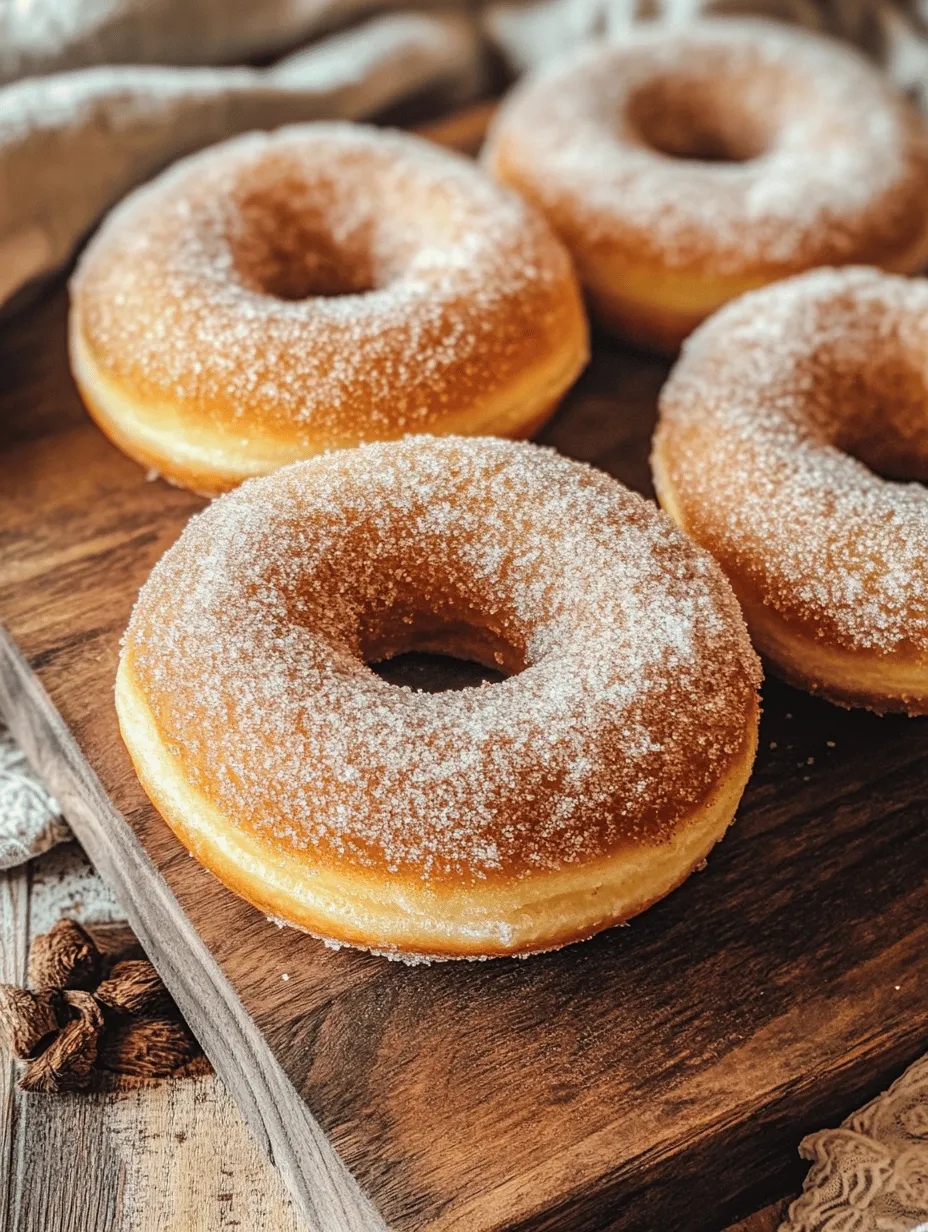As the leaves turn crisp and the air fills with the scent of autumn, one treat stands out in bakeries and home kitchens alike: apple cider donuts. This delightful pastry has become synonymous with fall, evoking memories of apple picking, hayrides, and cozy family gatherings. Their warm, comforting flavors, infused with the essence of apple cider and fragrant spices, create an irresistible combination that is hard to resist. Whether enjoyed fresh out of the oven or as a sweet snack on a chilly afternoon, apple cider donuts are a seasonal indulgence that brings joy to many.
The popularity of apple cider donuts has surged in recent years, drawing attention not just for their taste but also for their nostalgic appeal. The blend of sweet and spicy notes, coupled with the moist texture that apple cider provides, makes these donuts a perfect treat for any occasion. From festive Halloween parties to Thanksgiving celebrations, they fit seamlessly into the fall culinary landscape. In this article, we will explore the history and cultural significance of apple cider donuts, delve into the essential ingredients that make them so delectable, and guide you through the step-by-step process of creating your own batch at home.
The Allure of Apple Cider Donuts
Apple cider donuts have a rich history that dates back to the 19th century when apple harvesting was at its peak in the United States. Originally, these donuts were a way to utilize excess apple cider, a staple in many households during harvest season. As the tradition evolved, these delicious treats found their way into local fairs and farmers’ markets, quickly becoming a beloved autumn staple in many communities. Their unique combination of flavors and textures has contributed to their enduring popularity, making them a cherished part of American culinary heritage.
The cultural significance of apple cider donuts is particularly prominent in regions known for apple production, such as New England and the Midwest. In these areas, apple orchards often host festivals celebrating the harvest, where homemade cider donuts are served alongside fresh apple cider. Over the years, variations of the classic recipe have emerged, including gluten-free versions, baked options, and even creative flavor twists like maple or pumpkin spice. These adaptations showcase the versatility of the apple cider donut, allowing it to cater to a wide range of tastes and dietary preferences.
As fall rolls in, the appeal of apple cider donuts becomes even more pronounced. The combination of the changing seasons and the harvest creates a sense of nostalgia, drawing people to recreate the comforting flavors of their childhood. The warm spices, such as cinnamon and nutmeg, evoke memories of family gatherings and festive celebrations, while the sweetness of the donuts pairs perfectly with a cup of hot cider or coffee. It’s no wonder that apple cider donuts have become a quintessential fall treat, cherished by both young and old alike.
Essential Ingredients for the Perfect Apple Cider Donuts
Creating the perfect apple cider donuts requires a thoughtful selection of ingredients, each playing a crucial role in achieving that delectable flavor and texture. Here’s a detailed breakdown of each ingredient and its purpose in the recipe:
– Apple Cider: The star ingredient of this recipe, apple cider, is responsible for imparting rich flavor and moisture to the donuts. Using fresh, unfiltered apple cider will enhance the apple flavor and give your donuts the authentic taste of fall.
– Granulated Sugar: This ingredient provides the primary sweetness needed to balance the spices and enhance the overall flavor of the donuts.
– Brown Sugar: Adding depth and a hint of caramel notes, brown sugar contributes moisture and a subtle richness that elevates the donuts.
– Unsalted Butter: Essential for achieving a tender crumb, unsalted butter adds richness and flavor, making the donuts melt in your mouth.
– Egg: The egg acts as a binding agent, helping to hold the ingredients together while also adding moisture and richness to the donuts.
– Vanilla Extract: A splash of vanilla extract enhances the flavor complexity, creating a more rounded taste profile that complements the apple and spices.
– All-Purpose Flour: The foundation of the donuts, all-purpose flour provides structure and body. It helps create a tender yet sturdy texture that holds up to the moist ingredients.
– Baking Powder and Baking Soda: These leavening agents are crucial for achieving a light and airy texture. They create bubbles in the batter, allowing the donuts to rise beautifully during baking.
– Spices (Cinnamon and Nutmeg): The signature flavors of autumn, cinnamon and nutmeg, are essential for creating the warm, comforting taste that makes these donuts so special. They enhance the apple cider flavor and evoke the essence of fall.
– Salt: A small amount of salt balances the sweetness of the donuts and enhances the overall flavor, making each bite even more enjoyable.
– Coating Sugar and Cinnamon: The finishing touch, a blend of sugar and cinnamon, adds a sweet crust to the exterior of the donuts, providing an irresistible contrast to the soft interior.
With these ingredients at hand, you’re well on your way to creating apple cider donuts that will delight your family and friends. The combination of flavors and textures promises an indulgent treat that captures the essence of fall in every bite.
Step-by-Step Instructions for Making Apple Cider Donuts
Now that you have a grasp of the essential ingredients, it’s time to dive into the step-by-step process of making these irresistible apple cider donuts. Following these instructions will ensure that your donuts turn out perfectly every time.
1. Prepare Your Ingredients: Start by gathering all your ingredients and measuring them out beforehand. This will streamline your process and ensure you have everything on hand.
2. Preheat Your Oven: Preheat your oven to 350°F (175°C). This ensures that the donuts will bake evenly and achieve that perfect golden brown color.
3. Reduce the Apple Cider: Pour the apple cider into a saucepan and bring it to a boil over medium-high heat. Continue to boil until it reduces to about 1 cup, which will take approximately 10-15 minutes. This concentrated apple cider will intensify the flavor of your donuts.
4. Mix the Dry Ingredients: In a large bowl, whisk together the all-purpose flour, baking powder, baking soda, cinnamon, nutmeg, and salt. This ensures that the leavening agents and spices are evenly distributed throughout the flour.
5. Cream the Butter and Sugars: In another bowl, use an electric mixer to cream together the unsalted butter, granulated sugar, and brown sugar until light and fluffy. This process incorporates air into the mixture, contributing to the light texture of the donuts.
6. Add the Egg and Vanilla: Beat in the egg and vanilla extract, mixing until fully combined. This will add richness and enhance the flavor profile of your donuts.
7. Combine the Mixtures: Gradually add the dry ingredients to the butter and sugar mixture, alternating with the reduced apple cider. Start and end with the dry ingredients. Mix until just combined; be careful not to overmix, as this can lead to dense donuts.
8. Prepare the Donut Pan: Grease a donut pan with non-stick cooking spray or butter to prevent sticking. If you don’t have a donut pan, you can also use a muffin pan to create donut holes.
9. Fill the Pan: Spoon the batter into the prepared donut pan, filling each cavity about 2/3 full. This allows room for the donuts to rise without overflowing.
10. Bake: Place the donut pan in the preheated oven and bake for 10-12 minutes or until a toothpick inserted into the center comes out clean. The donuts should be golden brown and spring back when lightly pressed.
11. Cool the Donuts: Once baked, allow the donuts to cool in the pan for a few minutes before transferring them to a wire rack to cool completely.
By following these steps, you’ll create a batch of delicious apple cider donuts that will fill your kitchen with the warm, inviting aromas of fall. The next part of the recipe will guide you through the final touches, including how to coat your donuts for that extra special finish.

Comprehensive Guide Through Each Step of the Preparation Process
Preheating the Oven and Preparing the Donut Pan
Before diving into the delicious world of apple cider donuts, the first step is to preheat your oven to 350°F (175°C). This temperature is ideal for baking donuts, ensuring they rise beautifully while maintaining a soft, tender crumb. While the oven heats, take a moment to prepare your donut pan. If you’re using a non-stick pan, you may not need to grease it, but for added assurance, lightly coat each cavity with cooking spray or butter. This will make it easier to release the donuts once they are baked. If you don’t have a donut pan, don’t fret—muffin tins can work as a substitute, although the shape will differ from traditional donuts.
Reducing Apple Cider: Importance of This Step for Flavor Concentration
One of the most crucial steps in creating irresistible apple cider donuts is reducing the apple cider. Start by pouring 2 cups of apple cider into a small saucepan and bringing it to a gentle boil over medium heat. Allow it to simmer until the liquid reduces to about 1 cup, which can take approximately 15-20 minutes. This step concentrates the flavor of the cider, enhancing the overall taste of your donuts. The reduction process not only intensifies the sweetness and apple flavor, but it also helps to prevent the batter from becoming too watery, which can affect the texture of your donuts.
Mixing Wet and Dry Ingredients: Tips for Achieving the Right Consistency
Once your apple cider has reduced and cooled slightly, it’s time to mix your ingredients. In a large mixing bowl, combine your dry ingredients—flour, baking powder, baking soda, cinnamon, nutmeg, and salt. Whisk these together until evenly distributed, which helps ensure that the leavening agents are properly mixed throughout the flour.
In a separate bowl, whisk together the wet ingredients: the reduced apple cider, eggs, melted butter, and vanilla extract. When combining wet and dry ingredients, pour the wet mixture into the dry ingredients, stirring gently with a spatula or wooden spoon. It’s crucial to mix until just combined; overmixing can lead to dense, tough donuts. Aim for a batter that is slightly lumpy but cohesive—this will yield that delightful light and fluffy texture.
Filling the Donut Pan: Techniques for Even Distribution of Batter
With your batter ready, it’s time to fill the donut pan. To ensure even distribution, consider using a piping bag or a zip-top bag with one corner snipped off to pipe the batter into the donut cavities. This method helps minimize mess and ensures that each donut is filled uniformly. Aim to fill each cavity about three-quarters full to allow space for the donuts to rise without overflowing. If you prefer a more rustic approach, you can also use a spoon, but be mindful of maintaining even amounts across all cavities.
Baking Time and Temperature: Ensuring Donuts Are Perfectly Cooked
Once your donut pan is filled, place it in the preheated oven and bake for 10-12 minutes. The exact baking time may vary depending on your oven and the size of your donut pan, so keep a close eye on them. You’ll know they’re ready when a toothpick inserted into the center comes out clean or with a few moist crumbs. Avoid opening the oven door too frequently, as this can cause the temperature to drop and affect the baking process. Once baked, allow the donuts to cool in the pan for about 5 minutes before transferring them to a wire rack to cool completely.
Cooling and Coating: Importance of Rolling in Cinnamon-Sugar While Warm
This part is essential for that classic apple cider donut experience. While your donuts are still warm, prepare a mixture of granulated sugar and ground cinnamon in a shallow bowl. Once the donuts have cooled just enough to handle, roll each one in the cinnamon-sugar mixture, ensuring they are well-coated on all sides. The warmth of the donuts will help the sugar adhere better, creating a sweet, flavorful crust that complements the apple cider perfectly.
Understanding the Science Behind Baking
Explanation of How the Ingredients Interact During the Baking Process
Baking is as much a science as it is an art. The interaction between ingredients plays a pivotal role in the final texture and flavor of your apple cider donuts. The flour provides structure due to its gluten content, while the baking powder and baking soda act as leavening agents, producing carbon dioxide that helps the donuts rise. The fats—like butter—contribute to a tender crumb, while the sugars caramelize during baking, adding depth of flavor.
Discussion on the Importance of Not Overmixing and Its Effects on Texture
Overmixing the batter can develop the gluten in the flour too much, leading to tough donuts instead of the desired light and airy texture. When you mix just until combined, you allow the gluten to form minimally, resulting in a tender, fluffy donut. Remember, lumps are okay; they mean you’ve achieved the right consistency.
Insights into the Role of Temperature in Achieving the Right Donut Consistency
Temperature plays a crucial role in baking. Ingredients that are too cold can impede the rising process, leading to denser donuts. For best results, ensure eggs and butter are at room temperature to help the batter come together smoothly. Additionally, maintaining the correct oven temperature is vital; a preheated oven ensures that the donuts begin to rise immediately, allowing for that light texture.
Serving Suggestions for Apple Cider Donuts
Creative Ideas for Serving These Donuts
Apple cider donuts are a delightful treat on their own, but you can elevate the experience with a few creative serving ideas. Pair these warm, spiced donuts with a hot cup of apple cider or a rich, dark roast coffee to complement their flavors. The warmth of the beverages enhances the cozy feeling that these donuts provide.
Suggestions for Garnishing or Serving with Dips or Spreads
For an extra touch of indulgence, consider serving your apple cider donuts with a side of caramel sauce or whipped cream. A drizzle of warm caramel adds a sweet, buttery richness that pairs beautifully with the cinnamon and apple flavors. You can also create a simple glaze using powdered sugar and milk for a shiny finish that adds sweetness and makes the donuts visually appealing.
Presentation Tips for Making Them Visually Appealing
Presentation matters when it comes to enjoying food. Arrange your donuts on a rustic wooden platter or a decorative cake stand. Dust them lightly with additional cinnamon-sugar for a beautiful finish. You can also place a small bowl of dipping sauce in the center for an interactive serving experience, inviting your guests to choose their preferred accompaniment.
Storage and Shelf Life of Apple Cider Donuts
How to Properly Store Leftover Donuts to Maintain Freshness
While these donuts are best enjoyed fresh, you can store leftovers to enjoy later. Allow the donuts to cool completely, then place them in an airtight container at room temperature. To maintain their softness, consider placing a slice of bread in the container; the moisture from the bread helps keep the donuts from drying out.
Discussion of the Best Ways to Reheat for Optimal Taste and Texture
If you have leftovers, reheating them can restore their warmth and texture. The best way to do this is by placing them in a microwave for about 10-15 seconds. Alternatively, you can warm them in a preheated oven at 350°F (175°C) for about 5 minutes, which helps retain their crisp exterior while heating the inside.
Insight into the Typical Shelf Life of These Donuts
Apple cider donuts are best consumed within 2-3 days for optimal freshness. After that, they may begin to lose their delightful texture and flavor. If you need to extend their life, consider freezing them. Wrap each donut individually in plastic wrap and store them in a freezer-safe bag. They can last for up to three months in the freezer, ready to be thawed and enjoyed whenever the craving strikes.
Conclusion
Homemade apple cider donuts are a heartwarming treat that captures the essence of fall and the joy of cooking. With their spiced flavor, tender texture, and delightful sweetness, these donuts are perfect for gatherings, cozy afternoons, or simply as a personal indulgence. The process of making them—from reducing the cider to rolling them in cinnamon-sugar—adds an element of satisfaction that store-bought options simply cannot match.
Encourage your friends and family to experience the comforting flavors of these delicious apple cider donuts. With your newfound knowledge and the detailed steps provided, you can confidently create a batch that will delight everyone who takes a bite. So gather your ingredients, preheat that oven, and dive into the delightful world of homemade apple cider donuts. Once you do, you’ll never want to go back to anything else!



